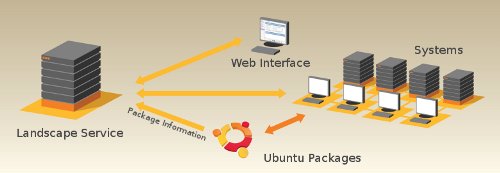When Ubuntu 9.04 (Jaunty Jackalope) arrives in April 2009, Canonical plans to introduce a separate surprise as well -- a new version of Landscape (image courtesy of Canonical). Never heard of Landscape? That will change in April 2009. Here's why.


When Ubuntu 9.04 (Jaunty Jackalope) arrives in April 2009, Canonical plans to introduce a separate surprise as well — a new version of Landscape (image courtesy of Canonical). Never heard of Landscape? That will change in April 2009. Here’s why.
Remember: Ubuntu isn’t just a desktop operating system. Canonical aspires to push Ubuntu onto servers and perhaps even into corporate data centers. A recent server relationship with Hewlett-Packard plus an Ubuntu Server Edition research report reinforce Canonical’s ambitions.
Painting A New Landscape
For Ubuntu to succeed on a range of corporate and mobile devices, it needs to be easily managed. Microsoft learned this lesson in the 1990s, and launched Systems Management Server (SMS) to assist Windows NT and Windows 95 deployments and management.
Similarly, Canonical offers Landscape, a SaaS platform and remote management tool that Canonical plans to more aggressively promote in 2009, starting with a significant upgrade in April.
Canonical’s Landscape Strategy
I traded email with Ken Drachnik, Canonical’s Business Manager for Landscape, to get a feel for where Landscape is heading. Here’s our conversation:
WorksWithU: How is Canonical positioning Landscape?
Drachnik: Landscape manages and monitors all your Ubuntu systems significantly reducing the complexity and cost of managing your Linux operating environments. Offered as a Software as a Service (SaaS) by Canonical, Landscape is a complete solution that helps IT administrators maximize the performance, availability and compliance of their IT infrastructure.
WorksWithU: Is Landscape an open source product?
Drachnik: The Client for Landscape is open source and available on Launchpad under a GPL license. However, Landscape is a paid for service from Canonical and the code is proprietary. You might be asking this because Red Hat has recently open sourced their RH Network software as SpaceWalk. Since Red Hat follows “procurement” model, you cannot get RH packages or updates without buying a subscription. So RH can provide their management code for free, because they charge customers for updates. Conversely, customers get very little value from Spacewalk unless they already have a subscription to RH.
Ubuntu follows an “acquisition” open source model in that Ubuntu AND updates are free. So we charge for a service to manage packages (essentially automating many of the tasks that sys admins do manually) and provide monitoring for systems. Anyone can get Ubuntu updates for free – this is central to our values – but we do ask them to pay for value added services like package management and monitoring, just like we charge for support and training.
WorksWithU: How does Canonical charge for landscape?
Drachnik: A subscription to Landscape is provided as part of a support contract from Canonical and is also available separately. Each machine under a support contract from Canonical receives a subscription to a Landscape account. Part of the benefit of Landscape is that users log their support cases through the service which simplifies troubleshooting of problems and aligns support communications with trouble tickets.
Separately, we also provide subscriptions to Landscape on a per client basis with discounts based on volume. Today, Landscape is offered as SaaS for desktops and servers connected to the internet. It also works well with intermittently connected systems (such as laptops). The list price for a subscription to Landscape is $150/client.
WorksWithU: Do you foresee a day when Canonical VARs and channel partners will use Landscape to remotely manage/troubleshoot Ubuntu servers and desktops for their customers?
Drachnik: Absolutely. As users deploy Ubuntu on more systems, the more complex management becomes and the greater the need to manage packages.
Customers can directly contact Canonical and buy a subscription to the Landscape service separately or purchase a support contract which includes a subscription to Landscape.
However, many customers often get their Ubuntu systems from VARs so there is a good case for a business model for VARs to provide front-end management and support for their customers. In this case, the VAR registers their customers’ clients with the Landscape server and the VAR manages the updates and monitors their customers’ systems. Just like VARs often provide front-end support for their clients and contract with Canonical for back line support.
We have some additional business models around Landscape for VARs that we are exploring with a few select customers now and will have details about in the next few months.
WorksWithU: Any Landscape upgrades planned?
Drachnik: Yes. Landscape, like Ubuntu, is on a development path providing updates every 6 months. The next version of Landscape is 1.3 which is due out in April 2009 so look for a detailed announcement then. Landscape was released in March of 2008 and version 1.3 represents our 3rd major release of Landscape features.
This next release is focused on features to make managing 1000’s of systems simpler and more intuitive and Cloud environments. As the number of machines you mange scales to thousands of systems, the GUI that Landscape uses needs to be designed to allow system administrators to quickly understand which systems need updates and which systems need attention.
We will also be implementing features that will enable users of Ubuntu in the Amazon EC2 Cloud to manage and monitor their Ubuntu instances. Users will also have access to a new knowledge base packed with articles about how to better use and deploy Ubuntu very shortly. And we are planning on expanding our alert capabilities to include SMS in addition to email.
Online Resources
At the end of our email exchange, Drachnik offered a few links to help readers find more Landscape information:
http://blog.landscape.canonical.com/
http://Canonical.com/projects/landscape
http://www.canonical.com/services/support
WorksWithU is updated multiple times per week. Don’t miss a single post. Sign up for our RSS and Twitter feeds (available now) and newsletter (coming in 2009).
About the Author(s)
You May Also Like


